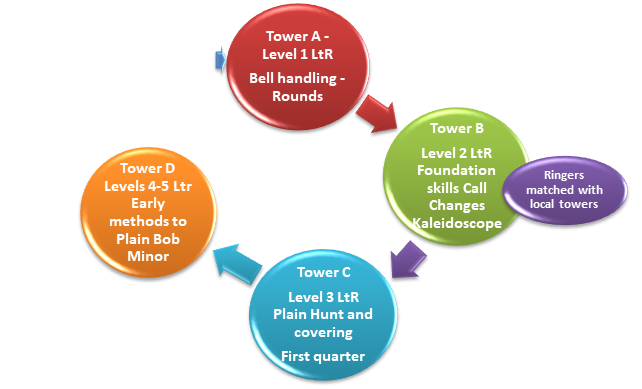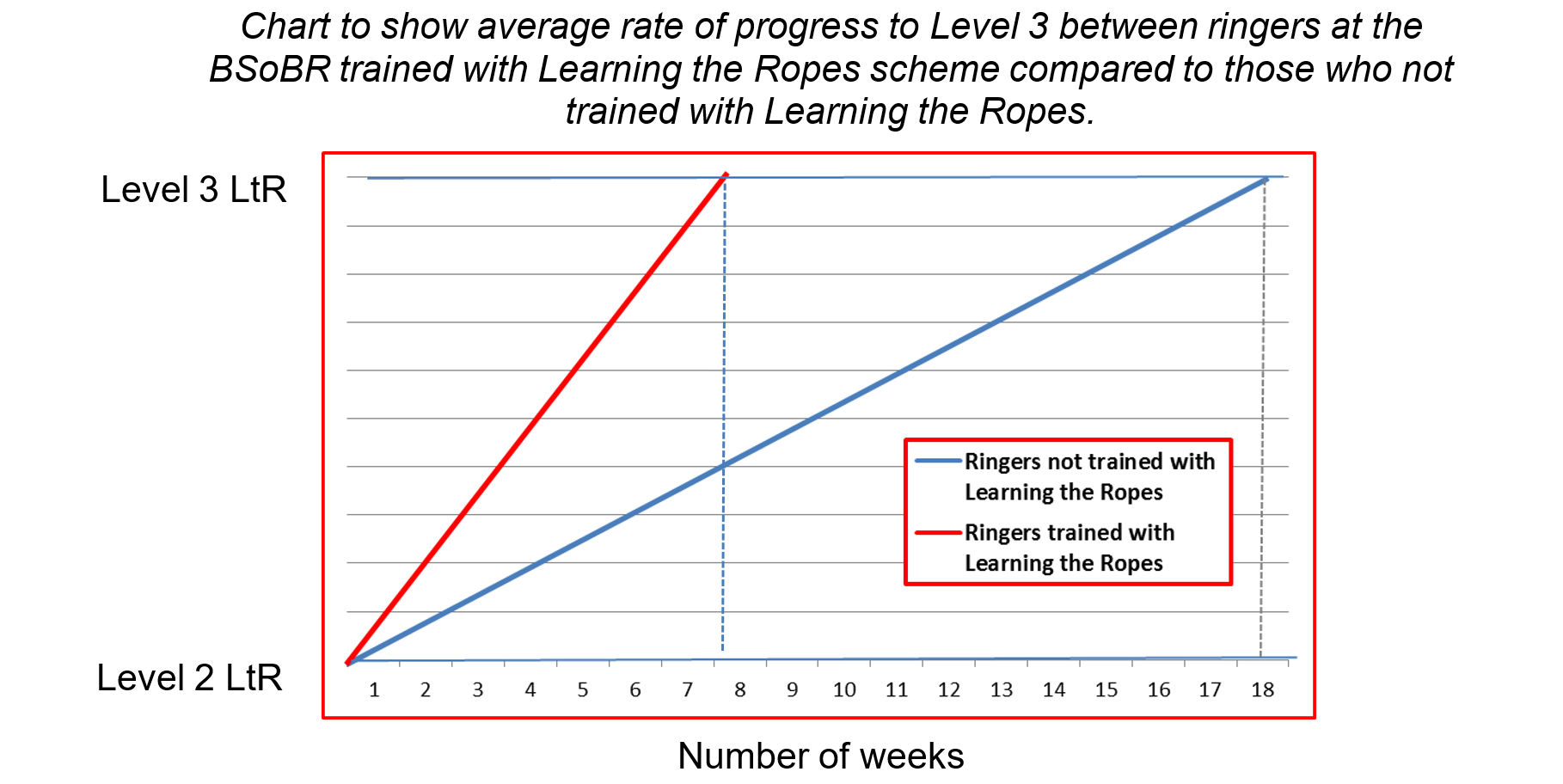The importance of foundation ringing skills
There are currently 21 ringers participating as students attending the Birmingham School of Bell Ringing. [BSoBR] Since its inception in September 2013, a total of 53 students have passed through the school.
St Paul’s in the Jewelry Quarter, equipped with computer simulators and a purpose built class-room, is the headquarters, and an additional three towers form the school.
The school runs four sessions every Saturday morning during term time, training taking place simultaneously between 10.15 and 12.15 and students follow the Learning the Ropes [LtR] scheme, provided by the Association of Ringing Teachers [ART]. BSoBR is committed to training new teachers and operates a mentoring scheme for those completing the ART Modules.
The LtR scheme takes new ringers from bell handling to a quarter peal of Plain Bob Minor inside in five stages called Levels. Each ringer will have rung six quarter peals on completion of the scheme.
After learning to handle a bell [LtR Level 1 - Bell Handling] at St Paul’s, ringers move on to Tower B – where they work on ringing Foundation Skills, [LtR Level 2 - Foundation Skills]. At this point they are matched with a local tower and join that band for practices and Sunday service ringing.

At the launch, in September 2013, the School enrolled students into Tower A [Working towards LtR Level `] and Tower C [Working towards LtR Level 3 Covering and Plain Hunt]. Those taken in to Tower C had been ringing for some time and made a self-assessment as to their capabilities. Tower B – [Working towards LtR-2 Foundation skills, Call Changes and Kaleidoscope Ringing] was introduced after one term, and Tower D – [Working towards LtR-4 early method ringing], after one year.
- 41 students have started at Level 1 and of these 11 have dropped out before learning to handle a bell unaided.
- Of the 30 who learned to handle a bell and passed their Level 1, 87% are still ringing.
- All of the students, bar one, who are currently working towards LtR Level 3 (Introduction to Change Ringing) and LtR Level 4 (Novice Change Ringer) have started ringing from scratch at LtR 1Level 1, with the BSoBR. It is not anticipated that any of them will have any difficulty moving on, or completing the method ringing stages. There have been two ringers who started at LtR Level 1 who have been unable to progress beyond LtR Level 2.
- 10 ringers joined the School at Tower C LtR Level 3 (Introduction to Change Ringing), having already learned to ring, anything up to 10 years before – of these:
- 4 did not complete LtR Level 3 – where a quarter peal on the treble is required to pass. One moved to an earlier tower to gain more experience at foundation skills.
- 6 completed LtR Level 3 – of these 4 moved on to method ringing but have not rung the required quarter peals, 2 were happy with their achievements but felt that method ringing was beyond them, leaving the School at that point.
- 9 out of the 10 ringers were unable to move on successfully to method ringing.
- 38 quarter peals have been rung by the students.
- 58 Learning the Ropes certificates have been awarded at this point – March 2016.
Summary
This information suggests that starting at LtR Level 1 as a novice gives the best prospect of a student progressing through all LtR levels. BSoBR has found that the longer students have been ringing, and the further they have got without having covered the foundation skills, and reached a sticking point, the harder it is for them to make any further progress.
Most of the attempts to teach them have resulted in the students deciding themselves that they are unable to progress at the speed that they want to and they have returned to ring at their own towers (in most cases better ringers than when they came to the School). Usually, this has been the student’s decision alone. In one or two cases, the decision has been made mutually by student and tutors and the students have been directed to local practices which have the capability of helping them consolidate and move on albeit at a more gradual rate. Often these practices are run by tutors from the School, so in a way we are still offering these students some support. BSoBR has also come to the conclusion that even with LtR, some students will still reach a ceiling beyond which progress is very, very gradual.
It has been noticeable that not covering the foundation skills of LtR Level 2 seems to create a significant barrier for students to make progress. Without exception, students arriving at the Plain Hunting tower [Tower C], who have started with the School from LtR Level 1 and progressed through LtR Level 2, do so with the required underpinning knowledge that has been gained by being properly prepared at the Levels below. They have been given technical tuition on how to change speed and know why this is necessary. The foundation exercises, with incremental steps, at LtR Level 2 have given them the skills to achieve it. They are also well grounded in theory: the importance of “position/place” in the row is stressed, as is an understanding of course and after bells. The average time taken for these ringers to achieve their LtR Level 3 was 6.8 weeks. Introducing the concept of “position” in the row and counting places after a student has already been attempting plain hunt (having learned to ring somewhere else) has almost always proved to be an uphill struggle, these ringers took much longer to progress to their LtR Level 3, taking on average 17.8 weeks.
Those ringers who had passed through the LtR scheme from the beginning moved from Level 2 to Level 3 in less than half the number of weeks than those who had not.

It is always important to explain to students why foundation skills are important because at the time students are taught the skills, the importance of them is not apparent. Perhaps this is why they were glossed over previously by teaching locally that did not follow the Learning the Ropes Scheme.

Clare McArdle
Birmingham School of Bell Ringing
» The Birmingham School of Bell Ringing
Learning the Ropes
Level 1
Ensures a new ringer has a strong basic technique. This is important, not only for safety reasons, but in order to facilitate the future progress of the ringer.
Level 2
Builds
the core skills that are essential for further progression. Foundation
skills should be practised until they are an ‘automatic’ ringing action.
Level 3
Takes ringers from Called Changes to Change Ringing, building up to ringing the treble and covering to methods.
Level 4
Reinforces
and builds on the skills developed in Level 3. Ringers progress to
ringing methods as part of a band of 5 or 6 ringers.
Level 5
The
final Level in the Learning the Ropes scheme, Level 5 guides ringers up
to confidently ringing methods and onto trebling to complex methods.